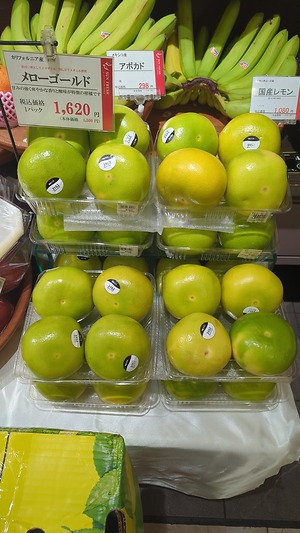


MeloGold Grapefruit
Estimated Inventory, 10 ct : 0
Description/Taste
Melogold grapefruits are large fruits that measure approximately 12 to 15 centimeters wide and 10 to 12 centimeters tall. They can weigh about 400 to 550 grams each, heavier than most grapefruit varieties. Their peel is smooth, thin, glossy, and somewhat pebbled, covered in small oil glands that release fragrant, essential oils. This peel generally ripens from green to bright yellow, with some green spots remaining at the fruits' maturity. Underneath the surface of the peel lies a thick, white, and spongy rind that's about 10 to 12 millimeters thick and encases the flesh of the fruit. Narrow membranes divide the flesh into 12 to 14 segments that easily separate when the grapefruit is eaten. This flesh has a translucent hue that can range from light yellow to medium yellow in color. It's aqueous, tender, and soft, encasing either a few seeds or no seeds at all. The core of the flesh may appear hollow or solid, depending on the individual fruit. Melogold grapefruits have a bright, citrus-forward fragrance and contain low acidity, contributing to the fruit’s mild, sweet, and subtly tart flavor.
Seasons/Availability
Melogold grapefruits are available from late fall to early spring.
Current Facts
Melogold grapefruits are botanically classified as Citrus × paradisi and are a hybrid cultivar belonging to the Rutaceae family, which includes all citrus. This variety was intentionally bred from a cross between a Pummelo and a Marsh grapefruit and was developed as a cultivar with a thin peel, low acidity, and sweet flavor. The name Melogold was created from a combination of mellow, used to describe the fruit’s mild flavor, and gold, a descriptor highlighting the fruit’s bright coloring. As a Pummelo hybrid, they are early maturing, allowing the fruits to be in season through January. Melogolds are closely related to Oro Blanco grapefruits, but growers prefer the former for their high productivity and ability to remain on the tree longer, extending the season and preventing premature fruit drop, a common issue in California citrus production due to weather changes.
Nutritional Value
Melogold grapefruits are an excellent source of vitamin C, an antioxidant that strengthens the immune system while reducing inflammation. They also contain vitamin A, a nutrient that helps with cell growth, oil regulation, infection defense, and reproductive, bone, and skin health. Melogold grapefruits have a small amount of magnesium and potassium, encouraging muscle, nerve, and heart function, healthy blood pressure levels, energy production, mood regulation, electrolyte balance, and kidney health. This variety provides the body with thiamine and folate to aid in digestion, cognitive function, white and red blood cell formation, and the prevention of birth defects in pregnant women.
Applications
Melogold grapefruits are ideal for fresh applications, as their juicy, soft flesh is best showcased when consumed straight, out-of-hand. Once their peels and rinds are removed, the flesh can be sliced, chopped, or segmented to be tossed into appetizers, fruit bowls, and green salads. Melogold grapefruits can also be used as a fresh topping for ice cream, cereal, yogurt, or granola. These fruits are frequently simmered into jams, jellies, and marmalades, chopped into salsa, or incorporated as a flavoring for sponge cakes, tarts, cheesecakes, custards, puddings, and muffins. Melogold grapefruit peels can be zested and used in savory sauces, meat dishes, soups, and stir-fries, or the rind can be candied and eaten as a sweet snack. This variety is frequently pressed into juices to flavor cocktails, sparkling beverages, fruit juices, and smoothies or blended into granitas and sorbets. Melogold grapefruits pair well with lemons, limes, oranges, mint, tarragon, parsley, cilantro, chile powder, honey, vinegar, lemongrass, arugula, spinach, watercress, asparagus, avocadoes, pomegranates, and mascarpone cheese. Whole Melogold grapefruits will keep up to 3 days at room temperature or 2 to 3 weeks when stored in a plastic bag in the refrigerator.
Ethnic/Cultural Info
Melogold grapefruits are among the many varieties from the United States that have found a place in Korean cuisine. South Korea imports a significant amount of grapefruit from the United States each year, valuing the fruit for its high vitamin C content and low calories and sugar. Grapefruits have become more popular than lemons in South Korea, as they are less sour and often more affordable. They are especially popular in beverages and desserts, frequently used to make a syrup known as cheong. This syrup is created by combining grapefruit with sugar in a 1:1 ratio, adding honey, and letting it sit for about a week to develop its sticky texture. The cheong syrup is then used in cocktails, salad dressings, and baked goods.
Geography/History
Melogold grapefruits were developed at the University of California Riverside’s Citrus Breeding Program by breeders Robert K. Soost and James W. Cameron. During these experiments, the University of California Riverside closely partnered with the Citrus Clonal Protection Program to develop varieties that could compete in quality and flavor with Asian citrus varieties but had adaptable characteristics for Californian climates. Melogold grapefruits were created by crossing a Siamese acidless Pummelo with a Marsh grapefruit, resulting in two sister varieties that were field-tested for over 20 years. One variety, Oro Blanco, was released in 1980 and praised for its similarity to its grapefruit parent, while the Melogold, released in 1986, was celebrated for its Pummelo-like qualities. Melogold grapefruits are cultivated both commercially and in home gardens, where they can be grown from seeds into trees. These fruits are sold throughout California at specialty stores and farmers' markets when in season. Melogold grapefruits may also be found in Japan, China, and South Korea.
Recipe Ideas
Recipes that include MeloGold Grapefruit. One

















